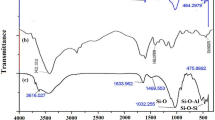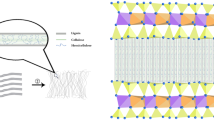Abstract
Batch lignocellulose-g-poly(acrylic acid)/montmorillonite (LNC-g-PAA/MMT) hydrogel nanocomposites were applied as adsorbents. The nanocomposites were characterized by FTIR, XRD, SEM, and TEM. The results showed that montmorillonite (MMT) could react with the monomers and change the structure of polymeric network of the traditional superabsorbent materials, an exfoliated structure was formed in the nanocomposites. The effect of process parameters such as MMT content (wt%), contact time (t), initial concentration of dye solution (C 0), adsorption temperature (T), and pH value (pH) of the dye solution for the removal of methylene blue (MB) from aqueous solution were also studied. The results showed that the adsorption capacity for MB increased with increasing contact time, initial dye concentration, and pH value, but decreased with increasing MMT content and temperature. The adsorption kinetics were better described by the pseudo-second-order equation, and their adsorption isotherms were better fitted for the langmuir equation. By introducing 20 wt% MMT into LNC-g-PAA polymeric network, the obtaining hydrogel composite showed the high adsorption capacity 1994.38 mg/g and economic advantage for MB. The desorption studies revealed that the composite provided the potential for regeneration and reuse after MB dye adsorption, which implied that the composite could be regarded as a potential adsorbent for cationic dye MB removal in a wastewater treatment process.














Similar content being viewed by others
References
Pearce CI, Loyd JR, Guthrie JT (2003) The removal of colour from textile wastewater using whole bacterial cells: a review. Dyes Pigm 58(3):179–196
Robinson T, McMullan G, Marchant R, Nigam P (2001) Remediation of dyes in textile effluent: a critical review on current treatment technologies with a proposed alternative. Bioresour Technol 77(3):247–255
Kim TH, Park C, Yang J, Kim S (2004) Comparison of disperse and reactive dye removals by chemical coagulation and Fenton oxidation. J Hazard Mater 112(1–2):95–103
Garg VK, Gupta R, Yadav AB, Kumar R (2003) Dye removal from aqueous solution by adsorption on treated sawdust. Bioresour Technol 89(2):121–124
Özcan AS, Özcan A (2004) Adsorption of acid dyes from aqueous solutions onto acid-activated bentonite. J Colloid Interface Sci 276(1):39–46
Kulicke WM, Nottelman H (1989) Polymers in aqueous media, performance through association. In: Glass JE (ed) Advanced in chemistry series 223. American Chemical Society, Washington, DC
Kost J, Langer R, Gombotz R (1987) Hydrogels in medicine and pharmacy. In: Peppas NA (ed) CRC Press, Boca Raton
Paulino AT, Guilherme MR, Reis AV, Campese GM, Muniz EC, Nozaki J (2006) Removal of methylene blue dye from an aqueous media using superabsorbent hydrogel supported on modified polysaccharide. J Colloid Interface Sci 301(1):55–62
Mussatto SI, Teixeira JA (2011) Lignocellulose as raw material in fermentation processes. http://www.formatex.info/microbiology2/897-907.pdf-2011-11-28
Wang L, Zhang JP, Wang AQ (2008) Removal of methylene blue from aqueous solution using chitosan-g-poly(acrylic acid)/montmorillonite superadsorbent nanocomposite. Colloids Surf A 322(1–3):47–53
Shawabkeh RA, Tutunji MF (2003) Experimental study and modeling of basic dye sorption by diatomaceous clay. Appl Clay Sci 24(1–2):111–120
Alexandre TP, Marcos RG, Adriano VR, Edvani CM, Jorge N (2006) Removal of methylene blue dye from an aqueous media using superabsorbent hydrogel supported on modified polysaccharide. J Colloid Interface Sci 301(1):55–62
Li Q, Zhao YH, Wang L, Wang AQ (2011) Adsorption characteristics of methylene blue onto the N-succinyl-chitosan-g-polyacrylamide/attapulgite composite. Korean J Chem Eng 28(8):1658–1664
Wang L, Zhang JP, Wang AQ (2011) Fast removal of methylene blue from aqueous solution by adsorption onto chitosan-g-poly(acrylic acid)/attapulgite composite. Desalination 266(1–3):33–39
Zhang JP, Liu Y, Wang AQ (2010) Study on superabsorbent composite XXV. Synthesis, characterization, and swelling behaviors of poly(acrylic acid-co-N-acryloylmorpholine)/attapulgite superabsorbent composites. Polym Compos 31(4):691–699
Lee WF, Yang LG (2004) Superabsorbent polymeric materials. XII. Effect of montmorillonite on water absorbency for poly(sodium acrylate) and montmorillonite nanocomposite superabsorbents. J Appl Polym Sci 92(5):3422–3429
Lin JM, Wu JH, Yang ZF, Pu ML (2001) Synthesis and properties of poly(acrylic acid)/mica superabsorbent nanocomposite. Macromol Rapid Commun 22(6):422–424
Li A, Wang AQ, Chen JM (2004) Studies on poly(acrylic acid)/attapulgite superabsorbent composite. I. Synthesis and characterization. J Appl Polym Sci 92(3):1596–1603
Özer A, Dursun G (2007) Removal of methylene blue from aqueous solution by dehydrated wheat bran carbon. J Hazard Mater 146(1–2):262–269
Chern JM, Wu CY (2001) Desorption of dye from activated carbon beds: effects of temperature, pH, and alcohol. Water Res 35(17):4159–4165
Chiou MS, Li HY (2002) Equilibrium and kinetic modeling of adsorption of reactive dye on cross-linked chitosan beads. J Hazard Mater 93(22):233–248
Hamdaoui O (2006) Batch study of liquid-phase adsorption of methylene blue using cedar sawdust and crushed brick. J Hazard Mater 135(1–3):264–273
Qada ENE, Allen SJ, Walker GM (2006) Adsorption of methylene blue onto activated carbon produced from steam activated bituminous coal: a study of equilibrium adsorption isotherm. Chem Eng J 124(1–3):103–110
Bhattacharyya KG, Sharma A (2005) Kinetics and thermodynamics of methylene blue adsorption on neem (Azadirachta indica) leaf powder. Dyes Pigm 65(1):51–59
Wang L, Zhang JP, Wang AQ (2008) Removal of methylene blue from aqueous solution using chitosan-g-poly(acrylic acid)/montmorillonite superadsorbent nanocomposite. Colloids Surf A 322(1–3):47–53
Cengiz S, Cavas L (2008) Removal of methylene blue by invasive marine seaweed: Caulerpa racemosa var. cylindracea. Bioresour Technol 99(7):2357–2363
Ho YS, McKay G (1999) Pseudo-second order model for sorption processes. Process Biochem 34(5):451–465
Hall KR, Eagleton LC, Acrivos A, Vermeulen T (1966) Pore and solid-diffusion kinetics in fixed-bed adsorption under constant-pattern conditions. Ind Eng Chem Fundam 5(2):212–223
Freundlich H (1907) Über die adsorption in lasungen. Z Phys Chem 57:385–470
Haghseresht F, Lu GQ (1998) Adsorption characteristics of phenolic compounds onto coal-reject-derived adsorbents. Energy Fuels 12(6):1100–1107
Fytianos K, Voudrias E, Kokkalis E (2000) Sorption–desorption behavior of 2,4-dichlorophenol by marine sediments. Chemosphere 40(1):3–6
Mall ID, Srivastava VC, Kumar GVA, Mishra IM (2006) Characterization and utilization of mesoporous fertilizer plant waste carbon for adsorptive removal of dyes from aqueous solution. Colloids Surf A 278(1–3):175–187
Acknowledgments
The authors would like to thank for supporting by Special Fund For National Forestry Industry Scientific Research in the Public Interest of China (No. 201104004), Inner Mongolia Natural Science Funds Projects (No. 2012MS0606) and Program For Young Talents of Science and Technology in Universities of Inner Mongolia Autonomous Region.
Author information
Authors and Affiliations
Corresponding author
Rights and permissions
About this article
Cite this article
Shi, Y., Xue, Z., Wang, X. et al. Removal of methylene blue from aqueous solution by sorption on lignocellulose-g-poly(acrylic acid)/montmorillonite three-dimensional cross-linked polymeric network hydrogels. Polym. Bull. 70, 1163–1179 (2013). https://doi.org/10.1007/s00289-012-0898-4
Received:
Revised:
Accepted:
Published:
Issue Date:
DOI: https://doi.org/10.1007/s00289-012-0898-4




